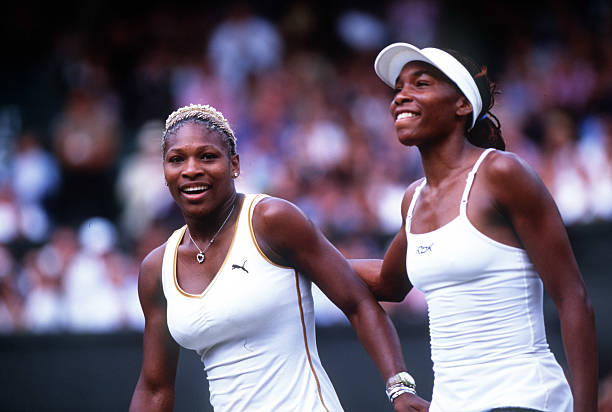Serena Williams, (one of) the greatest female tennis players of all time, is set to retire. In a career spanning across four decades, the American has had many iconic rivalries. In this article, I have undertaken the challenge of whittling them down to the top five.
To do this, I shortlisted all the players Serena has faced that have had a career-high ranking of No.3 or higher. I then looked at how many times Serena has faced each of them in the biggest events: Grand Slams, WTA Finals, Grand Slam Cup, and Olympic Games. Where there was a tie in the number of matches, the rivalry whose matches were more consequential (occurring in a later round and the winner advancing further in the tournament) was ranked higher. Without further ado, here are what I believe to be the Top 5 rivalries in the career of Serena Williams.
The Top 5 Rivalries of Serena Williams’ Career
5. Jennifer Capriati (USA)
Serena faced her compatriot Capriati eight times across Grand Slams (3-4) and the WTA Finals (1-0). In total, they played seventeen times between 1999 and 2004 with Serena leading the head-to-head 10-7. This rivalry doesn’t appear to be one that is talked about much, perhaps because of recency bias and only one of their Grand Slam matches occurring in the semifinals. Nevertheless, it was a fierce one that true tennis fans remember.
Ironically, their final match at the 2004 US Open (QF) was the most controversial, with Serena being subject to several incorrect line calls, although her 57 unforced errors also played a role in an eventual defeat. In fact, that match is often credited as the main impetus for Hawkeye being instituted in tennis tournaments worldwide.
4. Justine Henin (BEL)
Serena faced Henin eight times across Grand Slams (3-4) and the WTA Finals (1-0). In total, they played fourteen times between 2001 and 2010, with Serena leading the head-to-head 8-6. Whilst having the same amount of matches in big events as the rivalry with Capriati, this one ranks higher as their meetings occurred in later stages of the tournaments and the winner was the eventual champion on more occasions.
This rivalry was definitely seen as one of the iconic rivalries during the 2000s, a golden era of tennis for the women. The most memorable (and controversial) match in this rivalry was perhaps at the 2003 French Open (SF). Henin ended up winning the match with some “gamesmanship” (and went on to win the title), ending Serena’s run of four consecutive Grand Slam titles.
3. Maria Sharapova (RUS)
Serena faced Sharapova twelve times across Grand Slams (8-1), WTA Finals (1-1) and the Olympics (1-0). In total, they played 22 times between 2004 and 2019, with Serena leading the head-to-head 20-2. This is my most controversial pick in this list given how dominant Serena was in this match-up but it definitely is one of the most memorable rivalries of her career as a rivalry can be lopsided. A rivalry is defined as “competition for the same objective or for superiority in the same field,” and Serena and Sharapova are two of the all-time fiercest competitors giving their all for victory both on and off the court.
Ironically, the most important match-up these two had was one of Sharapova’s only two victories–the 2004 Wimbledon final. I believe the scale of Sharapova’s eventual star power is because it was Serena she beat in her first Grand Slam final (with the same being said for more recent Grand Slam champions, including Naomi Osaka). Whilst Sharapova always had the attributes to be a star off court, beating Serena (in straight sets and aged just 17) catapulted her to being the highest paid sportswomen for eleven years straight, which I don’t believe would have been the case had she faced someone else in that final.
This defeat for Serena defined this rivalry, as after 2004 Sharapova (despite going on to have a career that included four more Grand Slam titles) never won another match (and barely won any sets) against the American, as Serena always brought a high standard of play to their matches and refused to lose to the global megastar she created.
2. Victoria Azarenka (BLR)
Serena has faced Azarenka thirteen times across across Grand Slams (10-1), WTA Finals (1-0), and the Olympics (1-0). In total, they played 23 times between 2008 and 2020 with Serena leading the head-to-head 18-5. This rivalry was Serena’s most competitive rivalry during the 2010s, with Azarenka the only player to consistently challenge the American in her most dominant decade.
Their two consecutive US Open finals in 2012 and 2013 are most definitely remembered as some of best women’s Grand Slam finals of the 21st century.
1. Venus Williams (USA)
Serena has faced her sister Venus 20 times across across Grand Slams (11-5), the WTA Finals (2-1) and Grand Slam Cup (1-0). In total, they played 31 times between 1998 and 2020, with Serena leading the head-to-head 19-12. I don’t think the No.1 spot on this list could be given to any other rivalry than her one with Venus.
It is safe to say we will probably never have two siblings dominate (singles) tennis to the level which they did ever again. This rivalry has spread across four decades and has featured in many Grand Slam finals (including the first “Serena Slam,” where Serena beat Venus in four consecutive Grand Slam finals). Whilst the quality of their matches may not have always been as high as hoped (due to the difficulty of playing a sibling), they were always a spectacle with the build-up and occasion to matches bringing in fans that do not even follow tennis. Moreover, seeing two all-time great singles rivals team up as an all-time great doubles team is a nearly-unmatched standard.
With the last few years of the WTA thought of as the weakest in history (both in terms of quality and consistent star power), the absence of the Serena and Venus when they retire will be felt dearly. It seems likely that Venus’s retirement is also imminent (with her unable to win a match so far this year). Fans would have loved a chance to see this pair play one more time. Alas, the draw seems to have not cooperated. Still, this is a rivalry that will remain among the all-time best in history, with an extreme few that can match it.
Main Photo:
Embed from Getty Images






